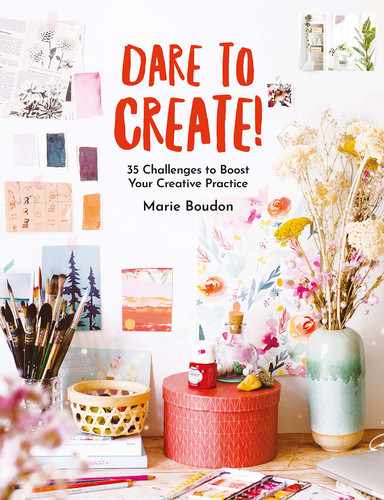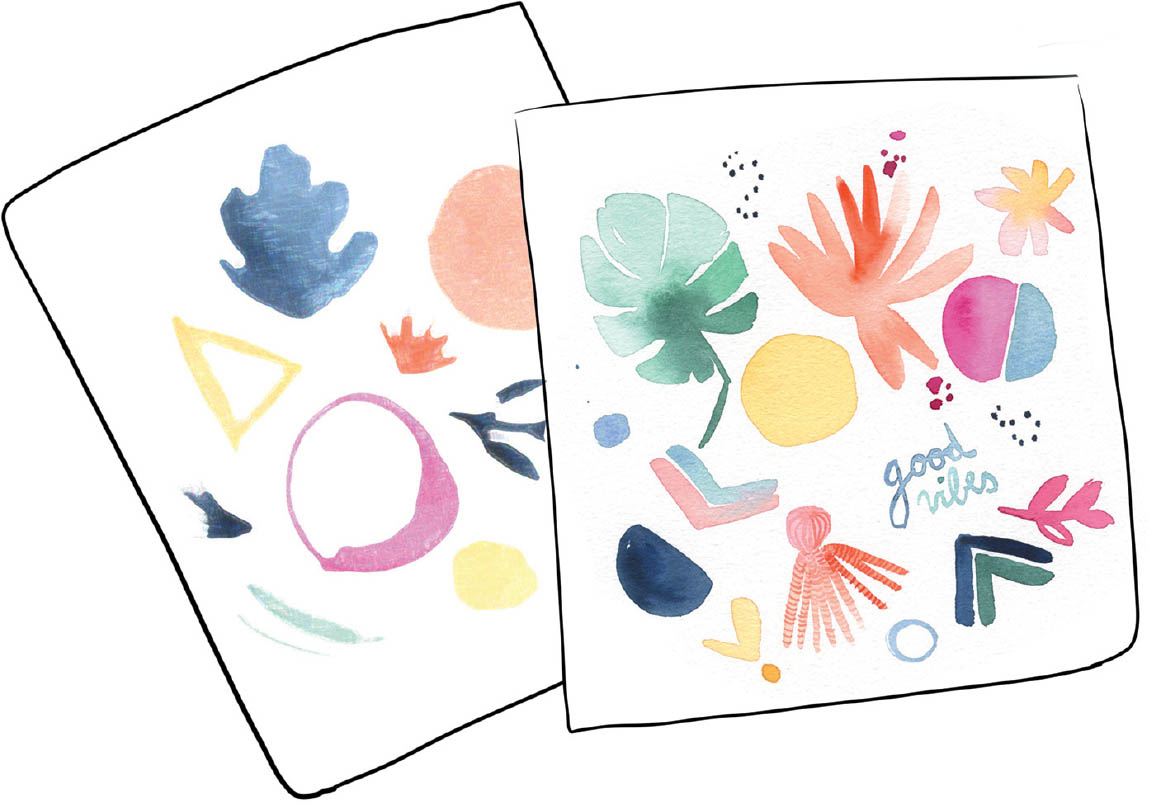 CHALLENGE 17
CHALLENGE 17 
Focus on quantity
AT THIS STAGE OF YOUR LEARNING, YOU WILL BE CREATING IN QUANTITY RATHER THAN LOOKING FOR QUALITY. DOES QUANTITY GET IN THE WAY OF QUALITY, OR IS IT, RATHER, WHAT MAKES QUALITY POSSIBLE? THESE FASCINATING QUESTIONS ARE WHAT WE ADDRESS IN THIS CHALLENGE. THE MORE YOU ASK OF YOUR CREATIVITY, THE MORE OF IT YOU WILL HAVE. WORKING IN QUANTITY ENCOURAGES YOU TO LET GO AND DISCONNECT. YOUR MOVEMENTS WILL BE MORE INTUITIVE, AND NEW IDEAS MAY BESIEGE YOU WHILE YOUR HANDS ARE OCCUPIED. WITH THIS CHALLENGE, TRY ONE OF THE THREE SUGGESTED EXERCISES IN ORDER TO PRODUCE AT LEAST FIVE PROJECTS IN ONE CREATIVE SESSION.
Why create in quantity?
An interesting example of the difference between quality and quantity is given in the book Art & Fear: Observations on the Perils (and Rewards) of Artmaking by David Boyles and Ted Orland, American photographers and writers. They tell the story of a pottery class in which the teacher separated the students into two groups: one concentrated on the quantity and the other on the quality of their productions. The first group was judged by the pound: they had to produce as many vases as possible in order to get a good grade. In the second group, the students were only allowed to produce one vase, but it had to be the most perfect one possible. At the end of this experiment, the teacher judged that the best vases were the ones produced in the first group. Indeed, by dint of producing vases, the students in the first group learned from their own mistakes and observations and improved their work, unlike the second group, which was concentrating on theory.
Integrating a stage of high-quantity production into your practice can only help you, as this interesting anecdote illustrates. You will make your art better, and you will get faster, be encouraged by all your results, find inspiration more easily, and develop your confidence. On his blog, the British illustrator and writer Alex Mathers puts a number on what quantity means to him: “I’d go so far as saying that you should not expect any traction until you have put out (published, shipped) at least 300 great pieces of work. This is the kind of quantity to look for, at the very least.”
Yao Cheng’s watercolor-covered office (see story on page 125)
Exercises for creating in quantity
Repeat, vary, constrain: these exercises will help you to create in quantity. You will return to the last two in part 5.
Repeat
Redo an exercise or an exploration for as long as you can feel that there is still progress to be made or as long as you feel curiosity. As in the example of the vases mentioned just above, try to make each attempt better. The fact of repeating will liberate you and give you confidence: the British actress and singer Julie Andrews believes that “perseverance is failing 19 times and succeeding the 20th.” You may have heard of the 10,000-hour rule, which was formulated by the Swedish psychologist Anders Ericsson. The idea is that by practicing a discipline for 10,000 hours, you become an expert in it.
However, I should say that I believe that the way that you practice is key, and not just how many hours you spend. Repeating an exercise should not be something that you do just to keep you busy and to give you the feeling of being productive. Redo it if you are learning something new. There is no point in doing something that you have already completely mastered. That does not mean that you should immediately stop an exercise once you have had your first success. Push it a little further in order to understand its subtleties and to have the feeling that something has clicked. Instead of just skimming across the top, the idea is to dig deep into the skills you care about the most and gain expertise in them. Not only that, but repetition is reassuring, because it takes away the pressure involved in new things.
I repeated the same exercise as long as I was learning something new or seeing an element I could improve.
I returned to the previous exercise, varying it in different color palettes.
Constrain
Repeat one of your favorite exercises with an extra constraint imposed on it. Different formats or just one, various colors, a variety of speeds, a change in tools: the possibilities are infinite. You will work more with constraints in challenge 25.
Vary
If a subject or a technique is particularly interesting to you, why not create four or five different variations of it? For instance, the photographer Steve Simon explains in his book The Passionate Photographer that he made forty photographs of Salem Sue, the largest cow statue in the world (located on top of a hill in New Salem, North Dakota). Having so many variations on the same subject allowed him to work in a multitude of different frames, thus getting stronger photos. In order to push this further, you will work with series in challenge 24.
I returned to the same exercise yet again and added a time constraint. I produced one version in three minutes and one in thirty minutes that was much more detailed.
Working in a small format
Carol Marine, the author of Daily Painting, a book about everyday painting, recommends working in a small format: this has a number of advantages for working in quantity. It’s easy to finish a piece in less than an hour, which contributes to the creation of a routine (challenge 18). The small format almost completely does away with the fear of not knowing how to finish, and your emotional investment is also much less.
You can also work on several small-scale projects at the same time so that you can alternate between them depending on your mood. Don’t think about it too much and follow your feelings to develop your spontaneity. One of your small paintings might give you the inspiration for the next day’s project.
![]() Your Turn
Your Turn ![]()
Practice one of the three exercises proposed in this challenge in order to create in quantity.
- 1. In one creative session, produce at least five finished products. Preferably, work in a small format to make it easier.
- What did you think of it?
- Did anything particularly interesting happen during this experiment?
- 2. Feel free to include these exercises in your regular practice, or even in your routine.




